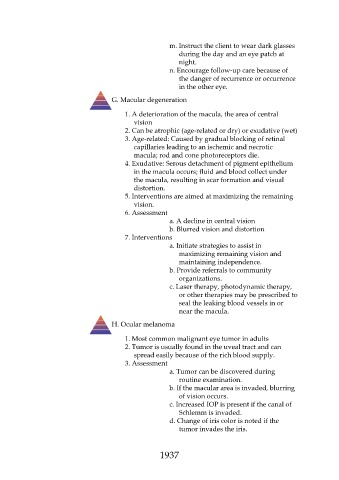Page 1937 - Saunders Comprehensive Review For NCLEX-RN
P. 1937
m. Instruct the client to wear dark glasses
during the day and an eye patch at
night.
n. Encourage follow-up care because of
the danger of recurrence or occurrence
in the other eye.
G. Macular degeneration
1. A deterioration of the macula, the area of central
vision
2. Can be atrophic (age-related or dry) or exudative (wet)
3. Age-related: Caused by gradual blocking of retinal
capillaries leading to an ischemic and necrotic
macula; rod and cone photoreceptors die.
4. Exudative: Serous detachment of pigment epithelium
in the macula occurs; fluid and blood collect under
the macula, resulting in scar formation and visual
distortion.
5. Interventions are aimed at maximizing the remaining
vision.
6. Assessment
a. A decline in central vision
b. Blurred vision and distortion
7. Interventions
a. Initiate strategies to assist in
maximizing remaining vision and
maintaining independence.
b. Provide referrals to community
organizations.
c. Laser therapy, photodynamic therapy,
or other therapies may be prescribed to
seal the leaking blood vessels in or
near the macula.
H. Ocular melanoma
1. Most common malignant eye tumor in adults
2. Tumor is usually found in the uveal tract and can
spread easily because of the rich blood supply.
3. Assessment
a. Tumor can be discovered during
routine examination.
b. If the macular area is invaded, blurring
of vision occurs.
c. Increased IOP is present if the canal of
Schlemm is invaded.
d. Change of iris color is noted if the
tumor invades the iris.
1937

